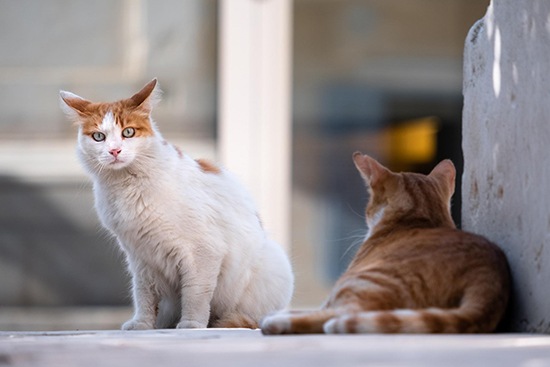WHAT IS TRAP, NEUTER, RETURN (TNR)?
In a nutshell: the most effective and humane approach to community cats. In more detail: colony caregivers and volunteers humanely trap community cats and bring them to a veterinary clinic, where they are spayed or neutered, vaccinated against rabies and distemper, ear-tipped, and given a basic checkup. After a 24-hour recovery period, the cats are returned to the exact location where they were initially trapped, and released there. The cats can live out their lives in their outdoor home, but won't be adding to the community cat population. Sterilized community cats will no longer display those often-annoying behaviors associated with mating, such as yowling, fighting, spraying, and of course, producing kittens. Cats who go through a TNR program live healthier individual lives, and the community receives the added benefits of having these community cats vaccinated against rabies.

HOW CAN I TELL IF A CAT HAS BEEN THROUGH A TNR PROGRAM?
If you see a community cat missing part of his or her left ear, that means the cat has been through a TNR program. This is called an 'eartip,' and an eartip is the universal signal that a cat has been spayed or neutered, and vaccinated against rabies and distemper. Community cats who have been through a TNR program are ear-tipped while they are under anesthesia for surgery, so if you see an ear-tipped cat - that means someone is looking out for that cat!
CAN’T COMMUNITY CATS JUST BE REMOVED OR RELOCATED?
No! Community cats live in an area because the resources - food, water, shelter - are there to support them. These resources may be provided by humans, or not. Rounding up the cats and bringing them to shelters (or rescues, or sanctuaries) does not solve the problem, plus the community cats will likely just be euthanized if they enter a shelter because they are not suited for life as an indoor pet cat. Relocation is also not a viable option. It is time-consuming and difficult, there is no guarantee that the cats will remain in the new location, and new locations for cats are very difficult to find. Removal or relocation efforts for community cats are not feasible.
HOW DOES TNR BENEFIT THE COMMUNITY AND THE SHELTER?
Because community cats are not suited to life as an indoor pet cat, the only outcome for these cats who are brought to the shelter is euthanasia. Euthanizing an otherwise healthy cat for simply living outdoors is not the compassionate thing to do, nor is it effective in the long run. The most humane and effective approach for community cats is TNR because it stabilizes community cat populations which over time decline naturally. Sterilizing community cats reduces the nuisance behaviors (spraying, yowling, fighting) associated with mating, which makes cats better neighbors. TNR also saves taxpayer dollars by reducing the number of kittens who are brought to the Shelter in need of socialization, basic supplies and care, medical care, and adoptive homes. Having fewer kittens, and not accepting community cats overall into the shelter, allows us more time and resources to focus on the indoor pet cats who need our help and care to find them a new home!
If you have a group of feral cats in your area, please call us (540) 943-5142 or email our TNR specialist and we can tell you what to do next.

